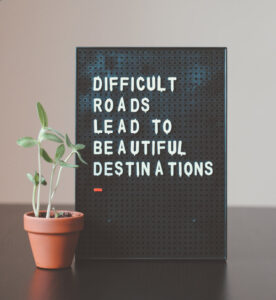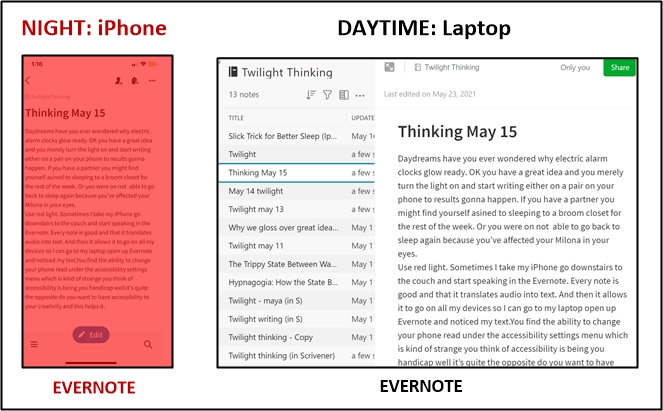
Photo by Johannes Plenio on Unsplash
How do you get ideas to fuel your creativity for innovation or problem-solving? I will describe one of my methods. Many of the ideas for this article came during the short period between sleeping and waking. To me it is a twilight zone. It happens for about 10 to 20 minutes while I wake up in the morning. It also happens for a few minutes when I get out of bed during the night. In either case, I may jot down a quick note about an idea. These are special times when there are fewer concerns about the quality of the idea. My need to ground ideas in “reality” is not present. I call the thinking I do during these times “twilight thinking.” It is a critical component of my learning, creative, and problem-solving processes.
I am taking advantage of the ebb and flow in the brain of two neurotransmitters. While awake, noradrenaline flows and prepares the brain for action. During REM sleep, noradrenaline disappears and acetylcholine increases. Acetylcholine is in the parasympathetic nervous system. Acetylcholine allows us to feel “calm and safe”, opening us up to a free flow of associative thinking. During the twilight zone, acetylcholine gradually lessens and noradrenaline appears. Then, there is enough acetylcholine to accept ideas without concern and enough noradrenaline to write them down.

Dali – Persistence of Memory
Melted Clocks
Artists have used this technique. For example, the painter Salvatore Dali said, “While we are asleep in this world, we are awake in another one.” He “walked the talk” and exploited the twilight zone. He did this by sitting before his canvas with a spoon in his hand when drifting off to sleep. While asleep, the spoon dropped from his hand, waking him. Then, he started painting to express any creative ideas he had while sleeping. Notice the dream-like qualities in his paintings, especially the melted clocks.
The Maya Story
Problem-solvers can use this technique. For example, my colleagues and I have two warfare models. Each simulates the collapse of the ancient Maya civilization. I spent the last year gathering reference data on 66 Maya sites to test each model. Now, I am writing a draft for the research paper. My colleague is using a precise approach to search for the best model parameters that fit the data. One problem is that the solution depends on the model parameters you start with. You may find a solution that fits the data, but it may not be the one with the closest possible fit. You vary the initial parameters until you convince yourself you have the best result. My colleague is very thorough and follows an innovative approach, which takes a lot of time.
I was very anxious. After spending so much time collecting the data, I wanted to see how the models fit. I wasn’t looking for the best fit, a good-enough fit would work for me. Several of my guesses came from insights I had during the twilight zone. After about a week of trying to fit the data, my solutions to both models were good enough to quell my anxiety. So far, he only has a solution to the first model, which, as expected, is much better than mine. There are two points I want to make with this story.
1. Priming
To get insights or ideas from the twilight zone, I need to prime the pump. That means I need to immerse myself in a problem and start thinking about it before I fall asleep. I use the twilight zone to work on practical problems. I wondered what would happen to questions that don’t have answers. Sometimes before drifting off to sleep, I ask, “Why is there something rather than nothing?” Our current universe came from an explosion. What came before? The ideas that percolate up have to do with time itself. I am sure that “time” is not what it seems to be. Perhaps Dali is on to something with his paintings of melted clocks.
2. Judging an Idea’s Value
Selecting solutions to the Maya collapse is like selecting rough ideas to pursue. That was an insight I had while within the twilight zone. Each solution to the Maya collapse tells a story. Each suggests which factors within the model contributed to the Maya collapse. Some solutions fit the data better than others. Yet, the solution with the second best fit might be closer to what happened 1500 years ago. Although not the best solution, it is close enough to the data to be a viable option. This is something we need to address in the paper.
Twilight thinking provides a similar situation. We can get ideas for a creative project from many sources. Some ideas we get from the twilight zone may appear too abstract

Photo by Hello I’m Nik on Unsplash
or strange to consider. Do we abandon them? Do we take instead, more concrete ideas that come from a waking state? Like the solutions in the Maya situation, each idea allows us to tell a story. How do we decide which ideas to pursue? Or which story to tell?
Justin Berg provides some insight. In 2019, he wrote the paper “When Silver is Gold: Forecasting the Potential Creativity of Initial Ideas.” It is about how people rank their rough initial ideas. Berg found people are not good at ranking the “potential creativity” of these ideas. They rank the ideas that are easy to apply and less concrete first. He said that ideas ranked second best “tended to be best in the end.” Berg suggests “asking why ideas may be promising before selecting which to pursue.” He is asking them a meta-question to reflect on their choice. I might follow with “What do you realize about what you discovered?”
Berg also said “if time and resources permit, develop two rather than one idea to maturity. Choose a surer bet and a riskier bet, but develop the riskier bet first so you don’t get anchored by the sure bet (see Walsh 2019).”
Cautionary Tale
Twilight thinking comes with its own cautions. Einstein kept a notebook by his bed at night to capture ideas. Will this work for you? You wake up in the middle of the night with a great idea. You reach over and turn the bedroom lamp on, grab your notebook and soon encounter problems. Your partner wakes up so annoyed that you find yourself banned to sleep in the broom closet for a week. Or, the bright light suppresses your melatonin levels and you can’t go back to sleep. If you decide to not capture the idea, you may forget it. What can you do?

Here are some solutions I used to capture ideas in the dark. Have you ever wondered why numbers on digital electric alarm clocks often use red light? Red light minimizes the effect of light on your sleep cycle. Star gazers use red light to view star maps. Red light does not destroy night vision. Before going to bed, I enable the red tint feature on my iPhone. I use the Evernote application to take notes. If the note is long, I take my phone to another room and use my voice to record the note. As I speak, Evernote translates my notes to text. When I finish, Evernote uploads the note to the cloud, which I can access from my laptop later. Then, I go back to sleep.
Last Thoughts

Photo by Joshua Earle on Unsplash
In this article, I focused on the “sleep-to-waking” transition. But ideas can come from other situations. I get them during relaxed moments while walking or taking a shower. Remember to have a way to take notes to capture them. And treat all ideas with respect.
In Neuro-Semantics, we have books on humorous thinking, hypnotic thinking, and metaphorical thinking. It’s a lot to think about. Yet, why not a book on “twilight thinking?” I will sleep on it. How about you?
References and Further Reading
Gambardella, Pascal. 2010. “Immersion Meta-State.”
Hall, L. Michael, 2020. Hypnotic Thinking. NSP: Clifton CO. This book, with its discussion of the parasympathetic nervous system, relaxation and creativity trances, comes close to this article’s topic.
Berg, Justin M. Berg, 2019. “When Silver is Gold: Forecasting the Potential Creativity of Initial Ideas.” Organizational Behavior and Human Decision Processes, Volume 154, Pages 96-117.
Walsh, Dylan. 2019. “Why Your Best Idea May Be Your Second Favorite. Research shows we can be more creative by selecting better initial ideas.” Insights by Stanford Business.
Wright, Craig. 2020. The Hidden Habits of Genius: Beyond Talent, IQ and Grit – Unlocking the Secrets of Greatness. New York: HarperCollins Publishers. Chapter 13. Now Relax.
Acknowledgements
I want to thank Claire Kurs for her editorial feedback.
Views: 226
 Pascal is a master modeler, who has modeled physical phenomena, satellite motion, and the behavior of people, organizations, and corporations.
Pascal is a master modeler, who has modeled physical phenomena, satellite motion, and the behavior of people, organizations, and corporations.